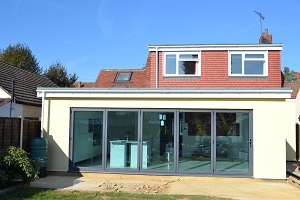 Permitted Development Home Improvements – What You Can Do
Permitted Development Home Improvements – What You Can Do
We have recently reported how property prices in Essex are continuing to rise as the county continues to be one of the most sought after in the country.
The high cost of family homes in the region means that it is now cheaper to extend a home rather than move house. Many people are put off extending because of the cost and time involved in creating plans, gaining permission and then going through the building work. However, a lot of work can be done under “permitted development”, which basically means that the council has already granted permission for you to carry out the work. So, why wait?
Renovating or expanding your home has many advantages, giving you more storage, a larger living space or even a spare room for when you have guests visiting. It’s extremely easy to get carried away planning décor and furnishings, but the most important thing to remember is that you need to plan properly.
The necessary paperwork for a permitted development like this is vital and it can save you a lot of trouble in the long run, especially if your home extension or development is deemed unsafe, meaning it has to be torn down. It’s not just extensions either – these rules can also apply to loft conversions and basement developments. To avoid this situation, do your research.
The main thing you need to know is that the rules and necessary paperwork can vary massively from one council to another, so even if you know about one set of regulations, it’s still best to check in. The rules also differ depending on what kind of development you’re planning.
Here’s an overview of the most common regulations, although again, do not forget to check with your specific local council to be on the safe side.
Basements
It’s quite uncommon for a basement development to require full planning permission. However this isn’t the case if it’s an excavation that involves a significant amount of work, if it’s going to be separate unit to your house, or the development will alter the external appearance of the property. If you are planning to renovate in a listed building, you’ll also need consent for both the internal and external work. Be aware that getting planning permission can be an extremely long and tedious process.
Regardless of whether a build requires planning permission or not, you will have to adhere to building regulations throughout, which covers things such as fire escape routes, damp proofing and water supplies. Contact your local planning authority and explain your proposed build thoroughly before you start on any work.
Loft conversion
 This is often the one that catches people out, but there are still a host of regulations that you should be aware of.
This is often the one that catches people out, but there are still a host of regulations that you should be aware of.
Similar to basement renovations, planning permission is not usually required. It often only applies if you will be extending or altering the roof space so that it exceeds specific conditions or limitations for your property. Your home could also have individual restrictions on it. Your local planning authority will be able to help you find out if this is the case.
Staying within the following limits, provided your house does not have specific restrictions, means you won’t have to apply for planning permission and you can save yourself a lot of hassle:
- For terraced houses, the development must be under 40 cubic metres of additional roof space
- For semi-detached and detached houses, the development must be under 50 cubic metres of additional roof space
In addition to this:
- Your extension cannot be higher than the highest section of the original roof
- The materials must be the same or similar to the existing house
- You cannot add a balcony, veranda or raised platform
- The roof, if enlarged, cannot hang over the outer face of the house wall
All of these rules sound quite complicated, but double checking with your council and then sticking to them will save you a lot of time in the long run and you can start your loft conversion with complete peace of mind.
Garage conversions
Again, they can be tricky as certain properties have restrictions placed on them as part of the house rules, for example if there is limited off street parking and it will compromise your private parking space. This is often the case for new developments or those in a conservation area. Your local planning authority will be able to let you know of any blocks and give you a clear indication of how they will affect your plans.
If there are no blocks and all of the renovations are internal, you can save yourself the hassle of applying for planning permission. However you will still require approval under the building regulations, which covers everything from flooring and ventilation to walls that are beneath ground level. New garages often also fall under permitted development.
Lawful Development Certificate
In all of these instances, the smart thing to do is to apply for a Lawful Development Certificate. Even when you know you do not require planning permission, it shows that your development is completely lawful. It’s also useful to have for if you ever decide to sell your property on and need to prove the work was legal and legitimate. Simply apply to your local council for a certificate and pay the required fee.
There are several ways to go about developing your home. You can opt to hire an architect who will design an extension and process the planning and building regulations on your behalf, and then hire a builder to carry out the work. If you know a good builder already, this is often a good way to do it. Alternatively, you could use an extension specialist, such as Essex Rooms, who provide a full design, planning and build service. This service is ideal for those who do not wish to get too involved in the extension – just let the experts take control.
Not only is an extension cheaper than moving, it will also add value to your home. for example, in Chelmsford you will struggle to find a 6 bedroom home for less than £600,000, but adding two rooms in the loft space of a four bedroom house will cost around £40,000. A nice little nest egg for the future! Here you can see an example of a home extension and loft conversion, that turns a small 4 bedroom home into a large 6 bedroom home.



